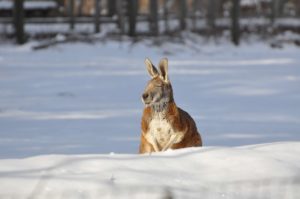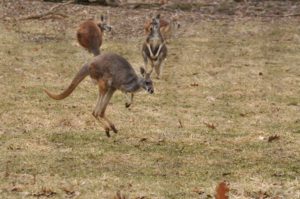RED KANGAROOMacropus rufus
Conservation Status: Low Risk / Least Concern
Although, loss of habitat may make it difficult to find food. They can be hunted in Australia and are similar to deer in Michigan. They are being conserved through ecotourism.

Learn More
Color:
Red kangaroos are known for their reddish color; however, they can range from red to a bluish-gray for both males and females (males tend to be redder). Adults have a black and white patch on the side of their muzzle and a white stripe on the cheek.
Size:
Males can get up to 6 ft. tall
Weight:
Males can weigh up to 200 lbs
Average Lifespan:
Up to 22 years
Captive Lifespan:
Up to 25 years
Near continental distribution across arid and semi-arid Australia, Absent from coastal and sub coastal regions of eastern, southern, and northern Australia.
The kangaroos live in the arid regions of mainland Australia (scrubland, grassland, and desert) and tend to prefer areas with intermittent shading from trees.
Mating:
Males compete for females and will have “boxing” matches.
Gestation/Incubation:
Embryonic diapause – the new embryo can be fertilized within days of giving birth, but then halts development until the newborn joey is about 200 days old (or less if the newborn joey dies). Because of this, kangaroos are efficient breeders and can have a young at foot, a young in the pouch, and a developing embryo all at once. Gestation is around 33 days.
Litter/Clutch Size:
1 Joey. They have a rather long suckling period of about a year.
Mature:
15-20 months for females and 20-24 months for males.
They eat grasses (usually young shoots) and succulents for water.
Like many of the macropods, the Red Kangaroo moves about by hopping or a pentapedal motion by balancing on their tail to help them make smaller motions. Ecosystem engineers: they shape the vegetation communities where they live. They are most active late afternoon or early morning = CREPUSCULAR. Kangaroos live in groups called “mobs” and red kangaroos are in groups usually ranging from 2-10 individuals (although larger groups may gather to eat and drink).
1. The red kangaroo is the largest living marsupial (meaning that the females have a pouch for their young – forward facing in the case of kangaroos) and the largest land mammal in Australia.
2. Red kangaroos can travel almost 30 ft. in one leap and jump 6-10 ft. high. When hopping, they can reach speeds up to 40 mph.
3. Dingoes are a natural predator of kangaroos, although raptors may take very young joeys. Humans are the primary source of predation. The aborigines used to use “firestick farming” to hunt kangaroos.
4. Since kangaroos cannot sweat, they can cool down by licking their forearms and letting it evaporate.
5. Female Red kangaroos are called ‘blue flyers’ because of the blue-grey color that is typical for their fur.




